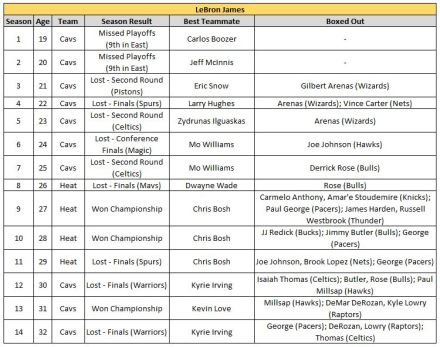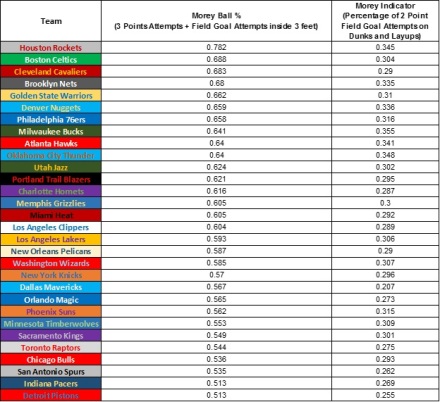The Golden State Warriors are NBA Champions, and for the first time in franchise history the Cavaliers must contemplate how to return to the promise land. Cleveland has a good problem – it has to figure out how to elevate itself from being a consensus top-two team in the NBA to being the best one. The rumors detailing where Kevin Love is likely to next don an NBA jersey have already begun to flurry, but in the event that Cleveland looks to maintain its big three, here’s what next year may look like.
The Cavaliers have eight roster spots accounted for, assuming Richard Jefferson continues his playing career. Four of those roster spots – Love, LeBron James, Kyrie Irving, and Tristan Thompson – lock in the consensus top-two starting lineup. Also on the books for next year are Jefferson, J.R. Smith – likely their fifth starter, Iman Shumpert, and Channing Frye along with Kay Felder’s partially guaranteed contract. The Cavs have no first round pick this year due to the swap for Kyle Korver and his perfectly-respectable-but-not-savior-like three point shooting from these Finals. Korver is an unrestricted free agent, and though he is unlikely to grab his nearly $10 million annual salary again on the open market, he is likely out of Cleveland’s price range. In place of the first round pick, the Cavs are likely to bring over wing Cedi Osman from Turkey whom they drafted after episode one of Cavs-Warriors. Though Osman is unlikely to be the difference maker in a fourth Finals tilt between the two teams, he profiles as a stretchy bench wing who could provide valuable minutes guarding two through four and meets the need of a team looking for two-way players.
Without trading Love, LeBron & Co. are likely looking down the barrel of free agency once again to fill the remaining seven roster spots (including the new two-way contracts). This year’s prospective crop of potential ring chasers has plenty of familiar names including Korver, Deron Williams, Chris Anderson, Mike Dunleavy, and Mike Miller. Outside of Korver, Cleveland would be wise to chase any of that group. For the past three years, the Cavs have wasted bench spots on James Jones knowing fully well that his only utility in meaningful games would be mop-up duty and secret handshakes.
In these Finals, Kevin Durant and LeBron both logged minutes at the five. Other teams are following suit in the small ball revolution, and centers can be had now for a dime a dozen. It’s why contracts like the one Timothy Mozgov inked with the Lakers last summer will haunt them for years. It also give the Cavs the ability to ignore the big man market entirely as their primary competition both in the East and the West downsize their rosters. In Thompson and Love (not to mention James), the Cavs already have the frontcourt depth necessary to go toe-to-toe with any other contender. Boston’s top two bigs are Al Horford and… Kelly Olynyk? Toronto benched Jonas Valencunias repeatedly in important minutes against the Cavs in favor of going small this postseason, the Wizards have Marcin Gortat – who reportedly wants out of DC himself. None of this is to suggest Cleveland should go the offseason without finding a backup for Thompson. Injuries happen, and having another big on the roster provides insurance as well as the occasional breather Thompson and Love. But the Cavs can take a page out of Golden State’s book and go dumpster diving for bigs willing to take the minimum.
But this revolution also makes it harder to part with Kevin Love. Even if the Cavaliers swindled the Pacers into a Paul George for Love and Osman deal, it would leave the Cavs bare along the backup big front. Gone is the lineup featuring Love at the five, with those minutes now either demanding even more of James or falling precipitously to whichever of the scrap heap bigs find their way to northeast Ohio. Alternatively, it could mean more minutes for Thompson who should continue to improve, but did nothing to strike fear in the hearts of the Warriors’ small lineups in the Finals. This summer’s crop of big men is unenviable. Outside of a few former Warriors (namely David West and Zaza Pachulia), there appear to be few impact players who would potentially take a minimum deal. Perhaps Zach Randolph will opt to end Grit and Grind in favor of a chance to play in June, or Boris Diaw’s contract won’t get picked up by the Jazz. Keeping Kevin Love in the fold makes names like Joel Anthony, Roy Hibbert, or even a return for Andrew Bogut more palatable.
The focus area for Cleveland this offseason will be to improve depth on the wing. The fifth starter spot likely belongs to J.R. Smith, with Shumpert serving as the primary backup/sixth-man. Since LeBron’s return, the Cavs have used trade exceptions to acquire depth on the wing in guys like Korver and Frye. Cursory looks at the roster provide all the insight needed to see that possibility crossed off this year unless a marquee name like Love or Irving are moved, leaving free agency as the only means for acquiring that depth. Derrick Williams is a likely candidate to return for the minimum, and the Cavs would be wise to bring him back. With the eight salaries they are committed to for 2017-18 already, Cleveland is over the luxury tax line and will be limited to one player on a mid-level exception and filling out the other spots with minimum salary deals. Assuming they guarantee the rest of Felder’s money and bring back Williams at the minimum, there would be five roster spots (plus the two two-way G League positions) left to fill.
Finding useful guys for those spots will be difficult and the best sell will be a chance at a championship, but even that may not be enough to sell this limited crop of free agents. Cleveland’s front office has likely stuck off every restricted free agent from its list as their incumbent teams would be sure to match the limited salary Cleveland can offer. Looking for veterans on the back nine of their careers appears to be the best option once again, but Cleveland will be hard pressed to find guys they won’t need to sub out for offense-defense switches late in games. The top unrestricted smalls in this year’s class who might take less for a shot at a ring are headlined by 40-year-old Vince Carter, defensive stalwart Tony Allen, Jose Calderon, Matt Barnes, and former Cavs Korver, Mike Miller, and Deron Williams. Of the group, only Carter and Barnes still show flashes of two-way guys. Carter is the name to watch from this group as he’s continually expressed a desire to continue his career and will have to critically examine whether continuing on in Memphis is his next step. Barnes, a player with two tours of duty in Golden State, seems a less likely fit as the Warriors could offer him the same money to return.
Enticing a younger player to take less than his worth will be difficult, especially with LeBron only promised to Cleveland for one more season. It’s rare that a player of David West’s caliber turns down millions even at the end of his prime in favor of better odds at competing in June. In order to roster bodies who can actually take minutes in those games, Cleveland will have to ask that of free agents this summer. The Cavaliers do have an oft-overlooked selling point that few teams outside of the Bay Area can offer – teams which advance to the Finals (win or lose) amass bonuses for their players, over $600,000 per player in 2016 (Conference Finals and Finals bonuses combined). That bonus excludes the amounts for regular season records as well as an additional payday for the NBA champions. It might not sound like much, but the veteran’s minimum this year will be around $1,000,000, so an opportunity to earn up to 60% more holds merit. Teams like Brooklyn and the Lakers have nothing to lose this season – they’re likely not playoff contenders and they don’t have their own draft picks to tank for – but even if they offer slightly more money than Cleveland as a base salary, these playoff incentives could tilt the total earnings in favor of the Cavs.
The extra $600K likely won’t be enough to sway the top targets – JJ Redick can still get more money from a San Antonio team which with Kawhi healthy is every bit as much a contender. It’s the next tier of free agents – PJ Tucker, Thabo Sefolosha, CJ Miles, Omri Casspi, Raymond Felton, or Anthony Morrow who might be convinced to take a bit less. Tucker, worth a second round draft pick himself last February, should demand at least the mid-level and a team like the aforementioned Nets may be inclined to give him even more. Sefolosha and Miles are both limited offensively, Casspi has his own warts with the Cavs, and Felton is likely only to backup Felder. Morrow could take on the Korver role for the minimum. Should the Kings decide to part ways with Arron Afflalo’s partially guaranteed deal, he would be an ideal fit as a three-and-D reserve. Taj Gibson is another curious name; a player built in the model of LeBron’s first running mate Carlos Boozer, he faces an uncertain market as a traditional four who teams will certainly experiment with as a small ball five. Gibson can’t stretch the floor behind the arc, but has a respectable mid-range shot and hustles on defense. If he were to take the mid-level, the Cavs might not need to play LeBron 44 minutes per game.
No name on this list is a perfect fit, but that is the situation that Cleveland’s front office has cap-strapped themselves into. By doling out big-money extensions to Thompson, Smith, and Shumpert, the Cavs find themselves with no money to spend and no assets to dangle. A combination of any two players named above would be an improvement over this year’s bench and that’s the kind of incremental growth Cleveland needs if it hopes to hoist the Larry O’Brien trophy this time next year.






